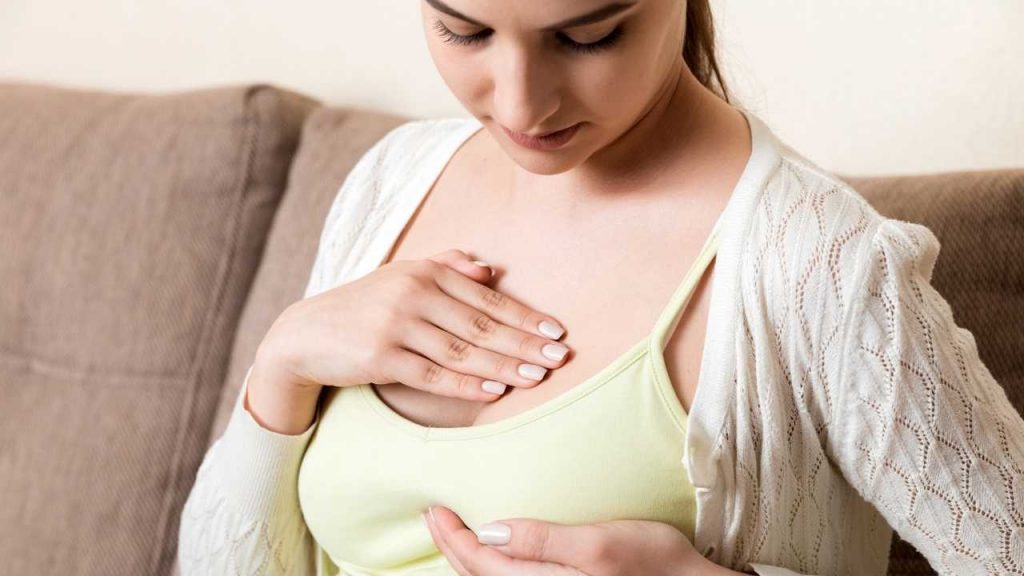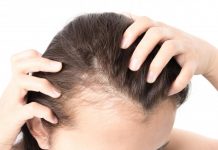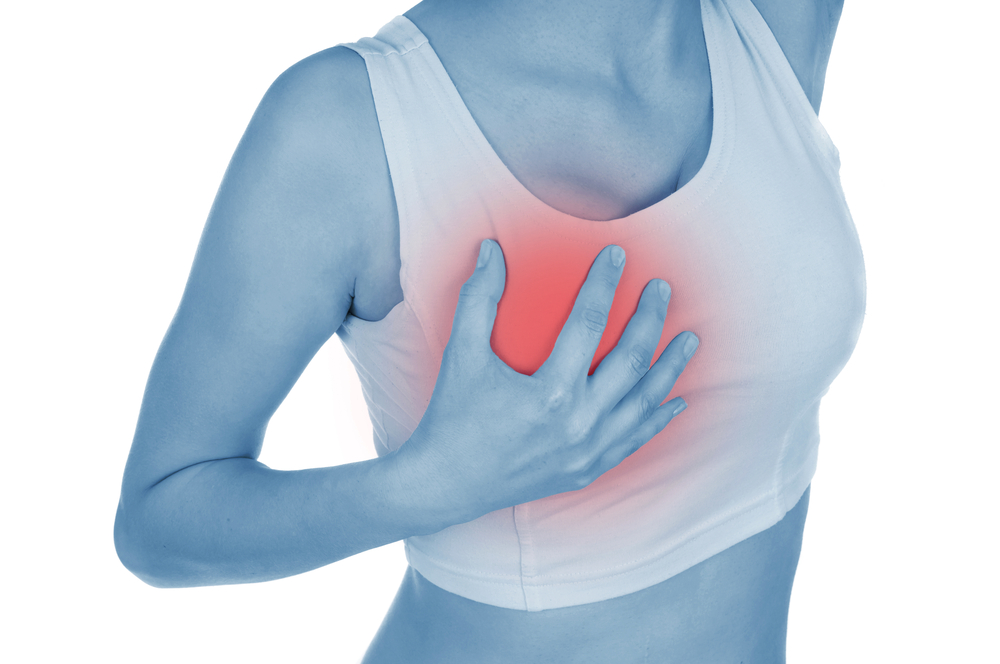Nipples can be affected by health problems the same as the rest of the body. In most cases, there is itching, irritation which are not serious problems but other changes are warning signs of breast cancer. Some women may experience discharge, swelling, and pain. Whatever the problem it is necessary to recognize worrying signs and consult to doctor to rule out anything serious.
7 Common Nipple Problems with Their Causes and Treatment
Mastitis
It is a condition in which the breast tissue becomes red and inflamed. Around one in ten women develop mastitis when they breastfeed their children. According to the NHS, mastitis is caused by a build-up of milk within the breast. Mastitis can happen due to various reasons including the baby not properly attaching to the breast when feeding, infrequent or missing feeds, or a baby having a problem in sucking.
Due to this breast tissue may become red and inflamed which is hot when touched. A burning sensation is experienced by a woman when she feeds the baby. In some woman’s nipple, discharge, and flu-like symptoms may be there. When build-up milk in the breast becomes infected with bacteria, we need antibiotics to treat them. Mastitis can develop in women who aren’t breastfeeding, but this is rare.
Breast Cancer
Any change in texture and colour of the skin and any change in the nipple can be a warning sign for breast cancer. Experts advise that every woman should check their breasts each month for signs of cancer because one in eight women develops the disease in their lifetime. The first sign of breast cancer is a lump or area of thickened tissue in the breast. If a woman notices any unusual changes in her nipples and boobs, then she should consult her doctor.
Paget Disease
Paget disease is a rare form of cancer that causes eczema-like dry skin patches on the breast and nipple. According to NHS, it is usually a sign of cancer in the tissue behind the nipple. Other symptoms of Paget’s disease are- itching, tingling, or redness int he nipples and areola, flaky, crusty skin, nipple appears more flat than normal, and there is yellow or bloody discharge. A doctor should check all of these symptoms and diagnose Paget’s disease.
Duct Ectasia
It is a non-cancerous condition in which milk ducts become wider. Duct ectasia may also cause blockage in the milk ducts due to which there is leakage of milk. There can be an infection, inflammation, and nasty abscesses due to blocked milk ducts.
Duct ectasia can cause pain, but it is not common. This condition is common in women who are approaching menopause due to hormonal changes. A woman should always go to the doctor if she gets any changes in her boobs.
Galactorrhea
When there is a milky discharge from one or both nipples it is known as galactorrhea. This is found in 25 percent of women.
Galactorrhea is caused by an increase in the hormone prolactin, by which the production of breast milk is stimulated. Certain medications like anti-depressants, blood pressure drugs, and anti-psychotics also cause discharge. Synthetic hormones present in contraceptive pills can also cause galactorrhea.
Intraductal papilloma
A small wart-like lump that appears close to the nipple is known as intraductal papilloma. It is formed in the milk duct and is usually harmless. A woman may experience pain, but it will not cause any discomfort.
Due to this, there can be a bloody and sticky discharge that leaks from the nipples, so consult to a doctor if that starts to happen.
Cracked Nipple
Many nursing mothers endure this. It is because of the poor latch at the breast and suction trauma due to improper positioning of the baby at the breast.
When To See A Doctor?
A woman should consult her doctor if she has:
- discharge from the nipples when she is not breast-feeding
- nipple discomfort from last few days
- a lump in the breast with nipple discharge
- changes in the skin around the nipple such as a change in color and texture of the skin
- breast pain or discharge, plus fever or chills which indicate infection
Diagnosis Of Nipple Problems
A doctor will examine the nipples and areola and ask a woman:
- about medicines, she is taking
- about any changes in her diet
- whether she might be pregnant
- about any recent exercise and activity that could have irritated her nipples
By doing this a doctor should have an idea about the problem and depend upon the cause doctor conduct following tests:
Ductography:
When there is nipple discharge then the doctor does a test to find out how many of the ducts that bring fluid to the nipples. This test is known as ductography. In this test, a dye is injected into the breast and then an X-ray is taken to monitor the function of ducts.
Mammogram
A mammogram is an imaging test in which the image of tissues inside the breast is recorded. This imaging test may reveal any lumps in the breast.
Skin Biopsy
A doctor may recommend skin biopsy if a woman has Paget’s disease, which is rare breast cancer. In this, a tiny piece of skin is removed from the breast for examination.
Prolactin Test
This a blood test in which the level of hormone which stimulates milk production is checked.
Thyroid hormone Test
This is a blood test that is done just to check if the thyroid gland is working properly or not.
CT or MRI scan is recommended by the doctor if none of the above tests are conclusive, to examine the breast further.
Treatment
Depending on the cause, there are different treatments available for nipple conditions.
- Mastitis: Antibiotics can clear the infection which is present in mastitis. An antibiotic that will not harm the child through the mother’s milk is prescribed by a doctor. An abscess is located through an ultrasound and drained by an incision.
- Galactorrhea: Treatment of this will depend on the underlying cause. A doctor recommends stopping the medication if it causes galactorrhea. They recommend an alternative treatment. A doctor may also advise a medication that can reduce the production of prolactin to treat galactorrhea.
- Ductal ectasia: Place a warm compress on the area by doing these symptoms of ectasia can be treated. This will soothe pain and reduce inflammation. To treat an infection, a course of antibiotics may be needed. Surgery may be required to remove the affected milk duct in more severe cases.
- Intraductal papilloma: The best method to treat intraductal papilloma is to remove the affected milk duct.
- Paget’s disease of the breast: Mastectomy which is a surgical procedure in which the affected part of the breast is removed is done for this condition. Removal of the nipple followed by radiation therapy is an alternative to a mastectomy.
- Cracked nipples: Proper positioning is essential for preventing trauma to the nipples. Apply warm compress, medical-grade lanolin ointment, salt water rinse, etc. are other options to treat cracked nipples.
- Breast cancer: Radiation therapy, surgery, biological therapy, hormonal therapy, and chemotherapy are options to treat breast cancer.
Prevention
We can prevent nipple problems by promoting nipple health. The following can help to promote nipple health:
- Keep the nipples clean when breast-feeding
- Wear suitable clothes during exercise to prevent friction
- Use products which prevent chaffing
- Change or stop the medications which cause nipple problems
References:
https://www.ncbi.nlm.nih.gov/books/NBK153481/













